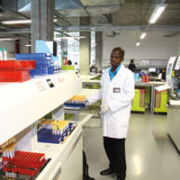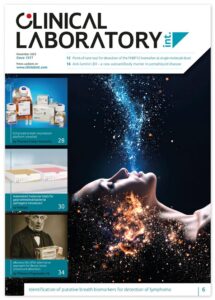Automation, consolidation and expansion in allergy diagnosis: embracing the future
The challenge of providing an effective allergy testing service in the face of the increased prevalence of the condition and a limited number of local allergists is being met by a centralised and specialised South African lab with the help of state-of-the-art equipment and facilities.
by Dr Cathy van Rooyen
Allergy is on the increase, especially in developing countries where industrialisation, lifestyle changes and socioeconomic factors lead to an increase in allergy prevalence. South Africa is no exception, as shown by data from prevalence studies of asthma in rural and urban populations [1]. The challenge in South Africa is to provide an adequate and comprehensive allergy service to a growing allergic population, in a healthcare system that has until recently been ill-prepared to meet allergy demands. South Africa has a dire shortage of trained allergists, as a postgraduate allergy diploma has only recently been introduced by the college of family medicine in South Africa and recognition of Allergy as a subspecialty of Paediatrics and Internal Medicine has only been introduced this year. There is no stand-alone postgraduate specialisation in Allergy or Immunology as seen in European countries.
The diagnostic laboratory not only faces the increased demands for allergy testing from the handful of clinicians with formal allergy training, but also the majority of requests from general practitioners without adequate allergy knowledge and who in conjunction with allergy testing, require in-depth interpretation of results, and advice on additional testing and patient management.
Allergy testing at AMPATH pathologists
AMPATH is one of the largest private pathology providers in South Africa and also provides the most extensive diagnostic service for allergy in South Africa. After consideration was given to the most effective model for the provision of this service, a model of centralisation of in vitro allergy testing was adopted. AMPATH built a National Reference Laboratory (NRL) for centralisation of allergy and other specialised tests, which has been operational since July 2011.
In addition to the centralised in vitro testing services offered, in vivo allergy diagnostics, including skin prick testing, intradermal testing and patch testing is also offered at selected centres. AMPATH also provides a diagnostic referral clinic for Allergy, where patients with complicated allergy can be referred for a detailed workup, which includes history, examination and appropriate testing. Patients are referred back to the clinician with a detailed report on the patient’s allergies and management advice. A separate service for allergen immunotherapy is also available at this clinic.
Centralisation of allergy tests in the AMPATH NRL
The AMPATH NRL is the main testing hub for specialised laboratory tests in AMPATH, South Africa. Centralisation has many advantages, which include cost-savings by increasing and optimising test volumes on a single platform and staff and resource savings, uniform test results, pooling of expertise in test performance and interpretation, etc. However, specimens do take longer to reach a centralised testing centre. The biggest challenge in such an environment is to provide a guaranteed and acceptable turnaround time (TAT), as many specimens are transported from various locations throughout the country.
The major factors that should be addressed to improve TAT are pre-analytical (easy registration of specimens, frequent, reliable and speedy transport, immediate specimen processing and sorting), analytical (24 hour continuous analysis of patient specimens on robust platforms with a large and high-speed processing capacity) and post-analytical (real-time result reporting and interpretation). It is also important to recognise that the perception of TAT for referred work from peripheral sites is largely influenced by intricate overnight transport options to the laboratory with same-night processing, ensuring patient result availability by 6h00 the following morning.
AMPATH rose to this challenge by providing logistical and pre-analytical solutions to transport specimens quickly to the AMPATH NRL using different transportation systems. Once the specimens reach the laboratory, processing is automated and specimens are sorted by high-speed sorters (Beckman automate 2550) [Figure 1] and transported regularly to the Serology Department, where allergy testing is performed. In the Serology department further sorting and aliquotting is performed by another high-speed sorter (Beckman automate 2550) down to test / analyser level. Specimens are processed continuously as soon as they reach their sorting targets.
From a logistic, quality, cost and time-management perspective, AMPATH adopted a policy of automation and consolidation of assays onto automated platforms where possible. A large autoline from Beckman Coulter was installed in the Autolab where various chemistry, immunochemistry and infectious disease testing was consolidated [Figure 2]. Allergy and autoimmune testing was not available on this system and after meticulous research a decision was made not to integrate third-party analysers onto the system. A separate system was therefore required to manage automation of allergy and autoimmune testing.
Previously allergy testing was done on one Phadia 1000 and two Phadia 250 instruments from ImmunoDiagnostics*. These systems were chosen for the quality of their assays, ease of use and reliability. We therefore looked to ImmunoDiagnostics for higher capacity instruments that would meet our needs. We were informed of the new Phadia 2500, which is an integrated and automated system which provides for high volume allergy and autoimmune testing on one platform. This would provide an ideal solution in terms of staff and space saving, easier workflow by consolidating tests on one instrument and increased processing capacity to accommodate increased test volumes due to centralisation. At the same time we would still have the same superior test quality that we require. Unfortunately the Phadia 2500 was not ready for installation when we moved into our new laboratory facility in July 2011, but ImmunoDiagnostics prioritised our request and our Phadia 2500 was installed in October 2011. After a full instrument validation, we have transferred all of our IgE mediated allergy testing as well as a significant portion on our autoimmune testing to the Phadia 2500 [Figure 3].
Performance of the new Phadia 2500 in the AMPATH NRL
We have been extremely happy with the performance of the Phadia 2500 in our laboratory. We have experienced the following advantages after switching to the system:
– Consolidation of allergy and autoimmune diagnostics onto one platform which can be operated by a single technologist, thereby saving one full time equivalent staff member.
– Space saving, as the footprint of the Phadia 2500 is significantly smaller than the three previous allergy and autoimmunity instruments (Phadia 1000 and two Phadia 250s)
– Continuous random access with continuous specimen processing.
– Large processing capacity, which eliminates bottlenecks over peak times.
AMPATH routinely tests for approximately 260 individual allergen-specific IgEs, but there are approximately 700 different allergens available which can be ordered when requested. ImmunoDiagnostics is also constantly adding new allergens and recombinant allergen components to its test menu. We are therefore able to offer the widest range of allergens available for allergy testing in South Africa.
Autoimmune testing in the AMPATH NRL
Patients are screened for connective tissue diseases using immunofluoresence on HEP-2 cells. In patients with positive screening tests, further testing is done by performing a connective tissue disease (CTD) screen for extractable nuclear antigens (ENA) on the Phadia 2500 instrument. This screen contains 16 Individual ENAs. Should the screen be positive, a breakdown of the individual autoimmune components is performed. The new Phadia 2500 streamlines this process through high sample throughput and software solutions which supports our workflow protocols, thereby ensuring optimal TAT.
Range of allergy tests performed in the AMPATH NRL
AMPATH’s main objective is to be the national leader in allergy diagnostics. This is not only beneficial for individual patients, but also leads to a competitive advantage in our local market. We spend a lot of time on research and development in allergy and also on implementing scientifically proven methods or tests in our testing repertoire.
In addition to IgE mediated allergy testing to crude allergen extracts, AMPATH is also placing emphasis on testing to different allergen components. This is either available as singular allergens on the Phadia 2500, or as part of a multiplex microchip array (ISAC or Immuno-Solid Array Chip) from ImmunoDiagnostics. The latest ISAC assay detects specific IgE to 112 recombinant allergens and can provide additional diagnostic insight by the prediction of cross-reactivity, prediction of risk for severe reactions, prediction of whether allergies will be outgrown and additional information on the heat-stability and bio-degradibility of certain allergens.
There has also been an increasing focus on cellular allergy (non-IgE mediated allergy) and AMPATH has expanded its test repertoire by offering Basophil Activation Testing (BAT) by flow-cytometry for foods and food additives, drugs, venoms and inhalants [Figure 4]. Our BAT was developed in-house, and commercially available allergens from Buhlman Laboratories are mostly used, except for drug allergies, where the suspect drug itself is used and tested in different concentrations in comparison to a non-allergic control patient. A similar testing strategy is followed for T-cell mediated allergies, where a modified T-cell proliferation assay (LTT) is used, mainly for drug allergies, metal allergies and occupational allergies. The demand for these services has increased substantially and cellular testing volumes are approaching a third of our total allergy testing requests.
A new philosophy in allergy testing – from bench to bedside
Experience has showed us that in vitro allergy testing only isn’t sufficient in our local environment.AMPATH has therefore instituted in vivo allergy testing at multiple allergy testing depots throughout the country. A range of in vivo allergy testing, such as skin prick testing (SPT), prick-prick testing, intradermal testing and patch testing may be performed at some of these depots.
Although AMPATH’s combined allergy testing services with careful interpretation by allergy consultant pathologists is usually adequate, there is a small minority of complicated patients that still require additional testing or for whom the most appropriate testing protocol cannot be identified. After becoming aware of this void, we decided to take allergy testing from the bench to the bedside by providing a diagnostic referral clinic for allergies and immunology. Clinicians can refer complicated patients to this clinic for an appropriate diagnostic service where the patient’s history and physical examination is considered before testing and management guidelines are given based on test result interpretation. Allergen immunotherapy is also provided where indicated [Figure 5].
Lessons learnt from centralisation and automation
Automation can lead to significant benefits in diagnostic pathology when applied appropriately. The full benefits of automation can only be reached when both pre-analytical as well as analytical steps are automated. Optimal workflow planning is essential to the success of the automation project. Automation works optimally in a simplified workflow environment – too many rules, exceptions and workarounds slow the process. Automation also works optimally if hardware, instruments and software are from the same supplier. Although third party analysers can easily be connected to an automated track, software may often not be fully compatible with middleware and can lead to suboptimal TAT.
The way forward
We want more automation, more integration and more consolidation. We envisage a smaller staff complement of highly trained staff. We are looking at more automation solutions, e.g. slide processing and other manual techniques performed in our serology department. We are also aiming to expand our cellular allergy/immunology department with further research and test development. We are also looking at software solutions to aid with allergy diagnostic interpretation, especially considering unique South African sensitisation patterns and cross-reactive allergens. Through these efforts and by dedication to our patients and clinicians, we aim to embrace the future of allergy diagnostics in South Africa.
References
1. Weinberg EG. Urbanisation and childhood asthma: An African perspective. JACI 2000; 105(2):224-231.
The author
Dr Cathy van Rooyen, MBChB, MMed Path, FRC Path
Ampath Laboratories, South Africa
*ImmunoDiagnostics (formerly Phadia) is part of Thermo Fisher Scientific



